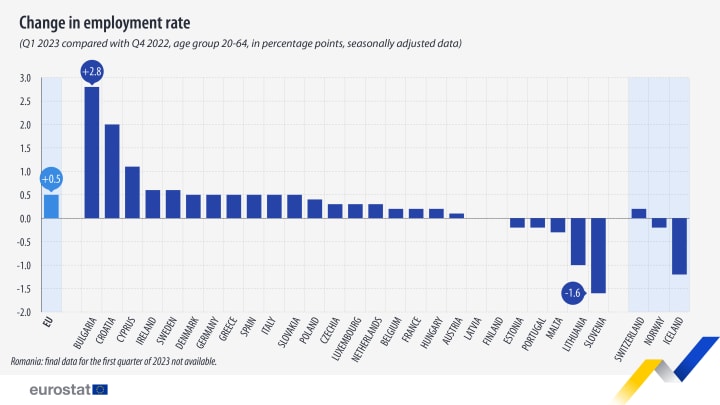Employment up and labour market slack down in Q1 2023
Employment Up and Labour Market Slack Down in Q1 2023: A Positive Economic Outlook

Introduction:
The labor market experienced significant improvements in the first quarter of 2023, as employment rates surged and labor market slack decreased. This positive trend signals a promising economic outlook and offers hope for job seekers and businesses alike. In this article, we will delve into the key factors behind the upturn, explore the implications for various sectors, and discuss the potential long-term impact on the overall economy.
Robust Job Creation:
Q1 2023 witnessed robust job creation across multiple industries, contributing to the overall increase in employment rates. Various sectors, such as technology, healthcare, and manufacturing, saw a surge in hiring activities. This was driven by factors such as increased consumer demand, technological advancements, and business expansion plans. Companies, buoyed by a positive economic climate, actively sought skilled professionals to meet growing needs, leading to a significant reduction in unemployment rates and improved job opportunities for job seekers.
Economic Recovery and Business Confidence:
The decline in labor market slack can be attributed to a strengthening economy and increased business confidence. As economies rebounded from the impact of the global pandemic, businesses regained their footing and grew more optimistic about future prospects. This renewed confidence prompted them to resume hiring and invest in expanding their operations. Moreover, supportive government policies and fiscal stimulus measures played a crucial role in creating a favorable business environment, stimulating economic growth, and encouraging companies to hire new talent.
Skill Mismatch and Talent Shortages:
While the overall employment picture improved, skill mismatch and talent shortages emerged as challenges in certain sectors. As industries rapidly evolved, the demand for specific skills and expertise intensified. This led to a disparity between available job openings and the skills possessed by the workforce. To address this issue, businesses and educational institutions must collaborate to bridge the skills gap through training programs, upskilling initiatives, and apprenticeship opportunities. By aligning skills development with industry needs, the labor market can better meet the evolving demands of the economy.
Sector-Specific Impact:
Different sectors experienced varying degrees of improvement in Q1 2023. Technology-driven industries, such as information technology and e-commerce, thrived due to the increased reliance on digital solutions and remote work. Healthcare sectors witnessed strong growth with rising demand for healthcare professionals and support staff. Manufacturing and construction sectors saw an uptick as infrastructure projects gained momentum. However, sectors heavily affected by travel restrictions and social distancing measures, such as tourism and hospitality, still face challenges in recovering fully. Efforts to revive these sectors will be vital for comprehensive labor market recovery.
Long-Term Economic Implications:
The positive employment trends and reduced labor market slack in Q1 2023 lay the groundwork for sustained economic growth. Increased employment rates contribute to higher consumer spending, driving demand for goods and services. This, in turn, fuels business expansion and investment. With a larger workforce participating in the economy, tax revenues increase, creating opportunities for public investment in infrastructure, education, and healthcare. Moreover, a thriving labor market fosters innovation, productivity, and entrepreneurial endeavors, further strengthening the overall economic landscape.
In the EU, the employment rate of people aged 20-64 stood at 75.3% in the first quarter of 2023 (Q1 2023), an increase of 0.5 percentage points (pp) compared with the fourth quarter of 2022 (Q4 2022).
Labour market slack – encompassing those with unmet employment needs, a large part of which includes unemployed individuals – amounted to 11.3% of the extended labour force aged 20-64 in Q1 2023 (-0.1 pp compared with Q4 2022).
This information comes from data on the labour market in the first quarter of 2023 published today by Eurostat. This article presents only a handful of findings from the more detailed Statistics Explained article.

Changes in the employment rate between Q4 2022 and Q1 2023 varied across the EU countries for which data were available. The highest increases were recorded in Bulgaria (+2.8 pp), Croatia (+2.0 pp) and Cyprus (+1.1 pp).

While employment rose in 19 EU countries, it remained stable in Latvia and Finland and decreased in 5 EU countries, with the biggest decreases recorded in Slovenia (-1.6 pp), Lithuania (-1.0 pp) and Malta (-0.3 pp).
Conclusion:
The first quarter of 2023 brought positive news for the labor market, with increased employment and reduced labor market slack. This signifies an improving economic outlook, with industries experiencing growth and job opportunities expanding. However, ongoing efforts are needed to address skill mismatch and support sectors still grappling with challenges. Continued focus on sustainable job creation and skills development will be crucial to ensuring long-term economic stability and prosperity.
About the Creator
Israr Ahmed
Israr Ahmed, tech blogger, shares the latest tech trends & advancements. Aims to simplify complex concepts & provide valuable insights to help readers make informed decisions about tech.






Comments
There are no comments for this story
Be the first to respond and start the conversation.